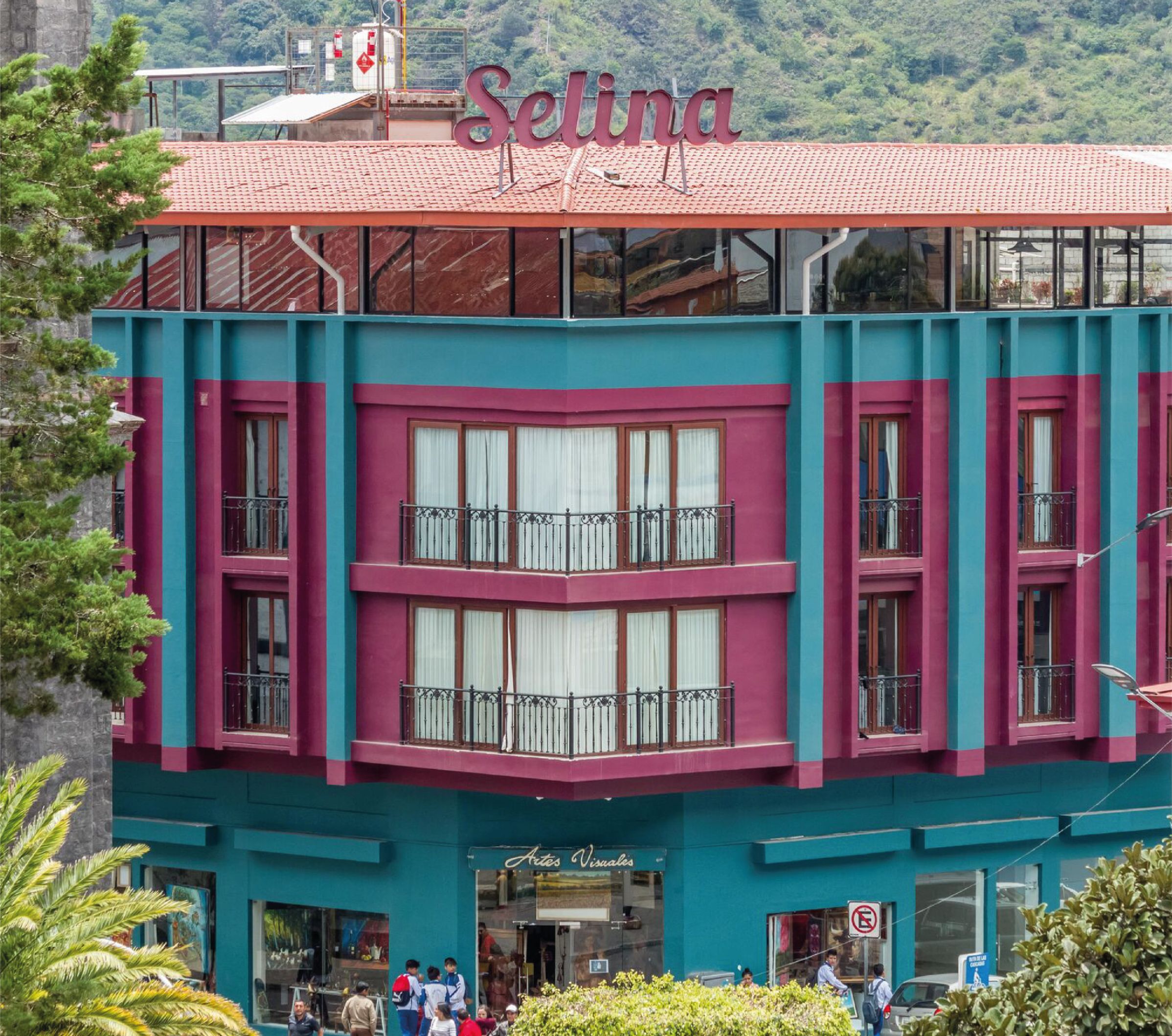Galapagos Islands: A Destination Like Nowhere Else on Earth
Also known as Islas Galapagos, the Galapagos Islands are Ecuador’s crown jewels. These incredible volcanic islands offer dramatic landscapes, intriguing wildlife encounters, and a wonderful respite from the cares of everyday life. Because this destination is so remote and there are some unique challenges associated with travel to the Galapagos Islands, it’s very important to start planning your trip well in advance. This guide contains everything you need to know about lodging options, weather, what to pack for a trip to Galapagos, and much more. Enjoy!
In this guide, we'll take a look at:
- 1. An Introduction to the Galapagos Archipelago
- 2. Galapagos Tours
- 3. How to get to Galapagos
- 4. Where to Stay
- 5. What to Do in the Galapagos Islands
- 6. What’s the best time to visit Galapagos islands Ecuador?
- 7. What to Pack for Your Galapagos Islands Travel Adventure
- 8. FAQ: Everything You Ever Wanted to Know About the Galapagos Islands
- 9. More to Explore
An Introduction to the Galapagos Archipelago
Sometime between three and five million years ago, the Galapagos archipelago was formed after a series of violent volcanic eruptions. Situated 563 miles off the coast of Ecuador, the chain consists of 19 islands and several smaller islets. These were untouched by humans until about the 1800s, when pirates and travelers began to visit while en route to other destinations. In 1835, Charles Darwin arrived and in his 1859 book On the Origin of Species, he aroused the world’s curiosity concerning the unique life found here.
100 years later, the Islands had the distinction of becoming Ecuador’s first national park. In 1978, the archipelago as a whole became a UNESCO World Heritage Site. Today, the islands are home to a small population of full-time residents and they receive approximately 200,000 visitors each year.
Galapagos Tours
All tours are conducted by guides who are licensed with the Galapagos National Park. Galapagos travel options include liveaboard cruises and land-based day trips on boats that take you from one island to another.
Visitors often ask about Darwin Island. While many see it from a distance, it has no dry landing sites and terrestrial visits – even from scientists – are few and far between. Because the waters around the island attract hammerheads, blacktips, silky sharks, and Galapagos sharks along with manta rays, green turtles, and a wealth of other marine life, it’s among the top sites for scuba diving around Islas Galapagos. If diving with whale sharks is on your bucket list, you have a good chance of encountering them in the waters around Darwin Island, nearby Darwin Arch, and Wolf Island, which is about 21 kilometers away.
It is possible to book day trips from Puerto Ayora in Santa Cruz, however most visitors find that it’s far more satisfying to travel on small tour boats that carry no more than about 30 passengers at a time.
Whichever option you prefer, it’s important to book at least a few months in advance and to do some research into what’s offered by various companies. Most tours are sold separately from flights, although there are some travel agencies that work alongside the airlines, offering group rates and booking internal flights on their clients’ behalf. If you are a diver, you’ll have to book even earlier. The number of dive boats allowed per site is limited and liveaboard reservations are snapped up fast.
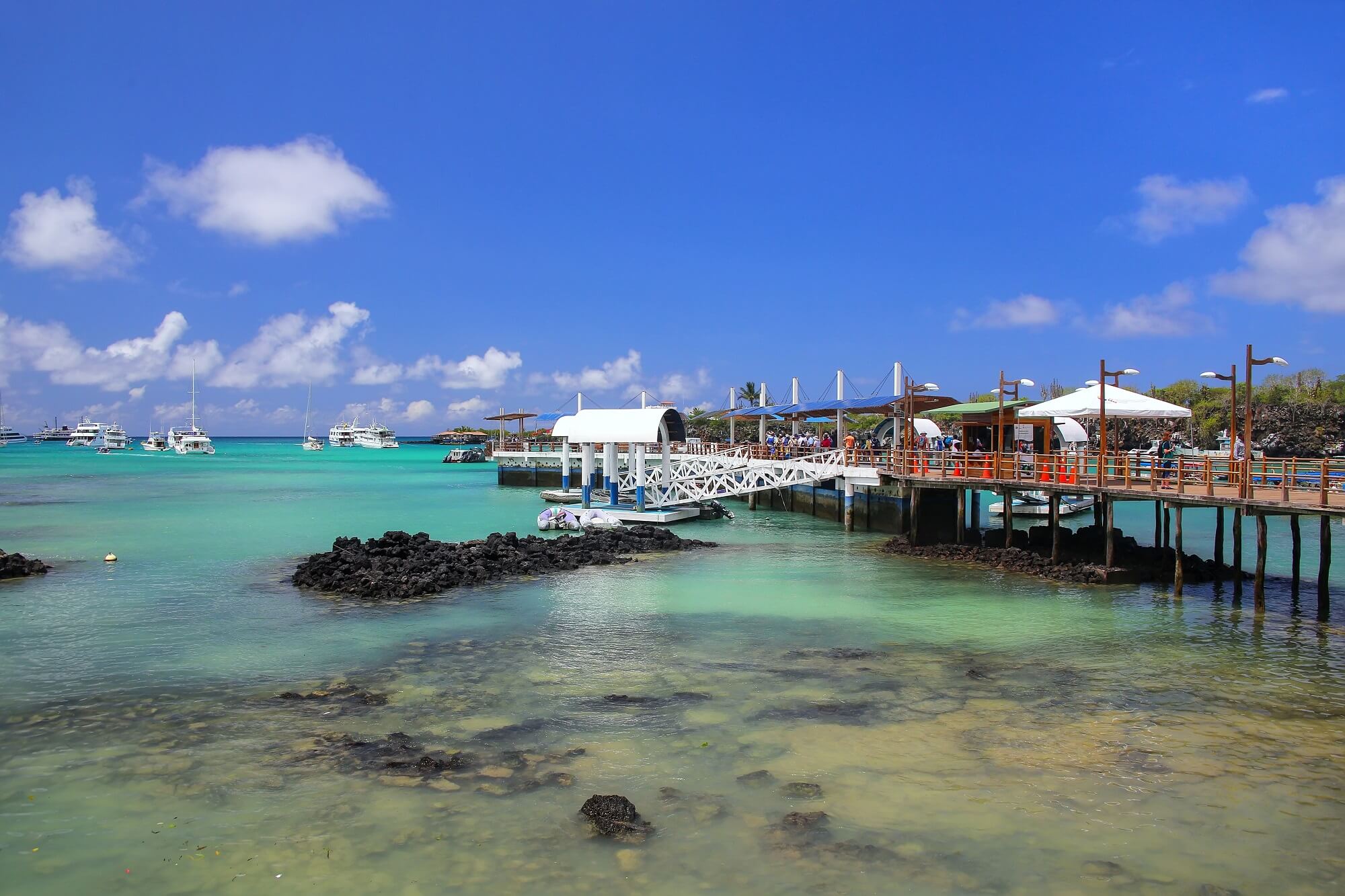
The Puerto Ayora boat dock at Santa Cruz Island Galapagos.
How to get to Galapagos
Traveling to Galapagos takes place in stages. Since there are no direct international flights to the islands themselves, the first step is to book a flight to Ecuador. Many people opt to travel to Quito as it is Ecuador’s capital and well worth a visit. Others find that it’s easier to fly into Guayaquil. Most Quito to Galapagos flights make a stop at Guayaquil before continuing on to the islands.
Almost everyone stays overnight on the mainland since the majority of Galapagos flights take place early in the morning or late in the evening. We recommend planning to arrive a minimum of 48 hours before connecting flights to Galapagos Islands airport in case your flight to Ecuador is delayed for any reason. This way, you’ll be on time, you’ll have had the opportunity to rest, and you’ll arrive at the Galapagos airport ready for the adventures you have planned.
Once you arrive at the islands, you have some different options for getting around depending on your itinerary and where you’re staying. You can rent bicycles in any town, and there are plenty of inexpensive taxis. Be prepared, because most taxis are pickup trucks and passengers ride in the back! Water taxis are available for short trips, as well.
For longer trips between islands, there are speedboat shuttles that can take up to 3 hours to get from point A to point B. These tend to be very bumpy and since seasickness is possible, it’s important to take a motion sickness remedy before your shuttle trip. A faster but pricier option is also available: There are inter-island flights daily between San Cristobal, Isabela, and Santa Cruz. Maximum flight time is typically 40 minutes.
Where to Stay
Many visitors – particularly divers – take advantage of liveaboards. Most liveaboard cruises are a week long although longer and shorter itineraries are available. You don’t have to be a diver to enjoy the way a Galapagos liveaboard brings you into close contact with nature: Naturalist cruises take you from island to island, treating you to a variety of land excursions as well as snorkeling.
Almost everyone stays overnight on the mainland since the majority of Galapagos flights take place early in the morning or late in the evening. We recommend planning to arrive a minimum of 48 hours before connecting flights to Galapagos Islands airport in case your flight to Ecuador is delayed for any reason. This way, you’ll be on time, you’ll have had the opportunity to rest, and you’ll arrive at the Galapagos airport ready for the adventures you have planned.
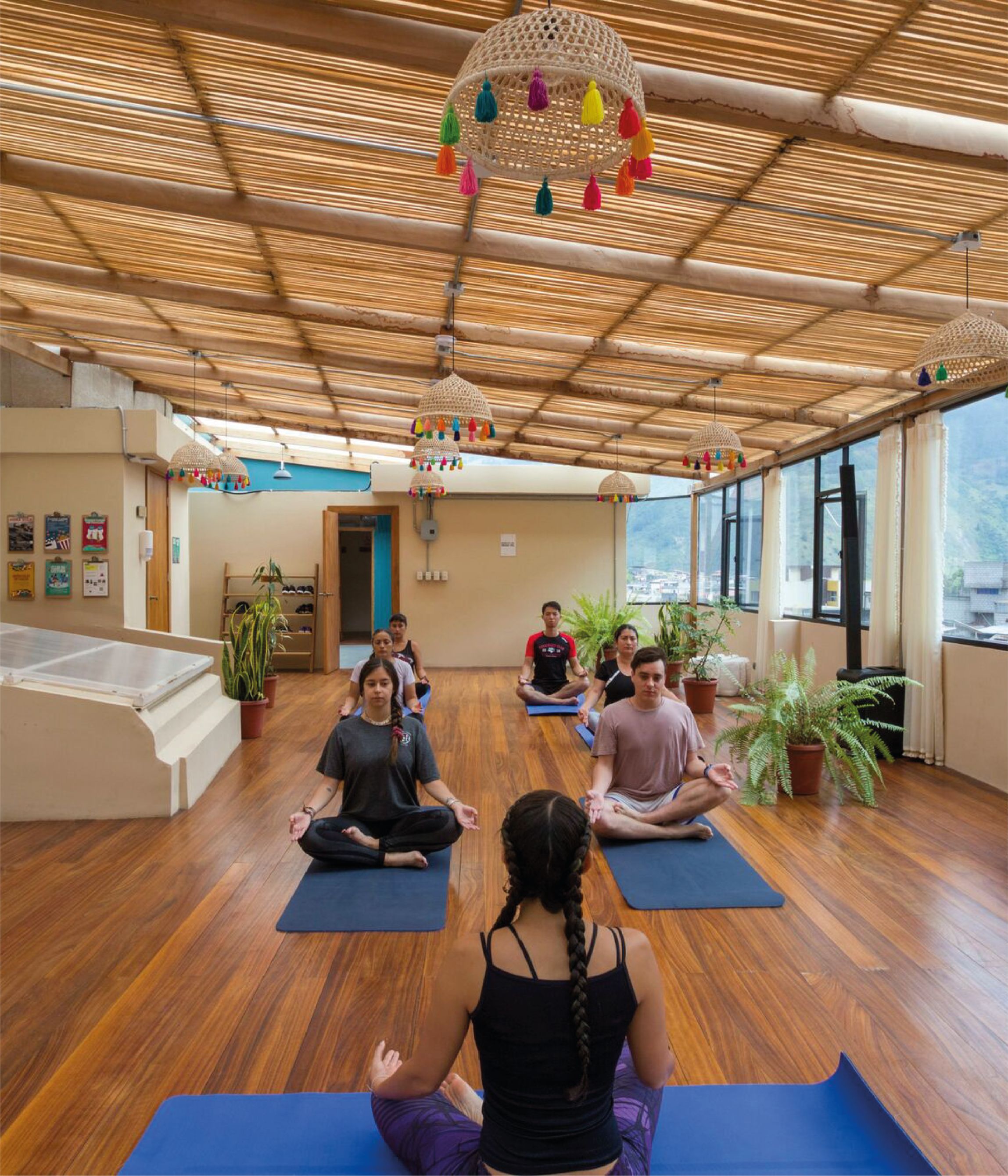
Embrace a life without borders! Work, stay, and explore at Selina Baños!
Once you arrive at the islands, you have some different options for getting around depending on your itinerary and where you’re staying. You can rent bicycles in any town, and there are plenty of inexpensive taxis. Be prepared, because most taxis are pickup trucks and passengers ride in the back! Water taxis are available for short trips, as well.
For longer trips between islands, there are speedboat shuttles that can take up to 3 hours to get from point A to point B. These tend to be very bumpy and since seasickness is possible, it’s important to take a motion sickness remedy before your shuttle trip. A faster but pricier option is also available: There are inter-island flights daily between San Cristobal, Isabela, and Santa Cruz. Maximum flight time is typically 40 minutes.
Where to Stay
Many visitors – particularly divers – take advantage of liveaboards. Most liveaboard cruises are a week long although longer and shorter itineraries are available. You don’t have to be a diver to enjoy the way a Galapagos liveaboard brings you into close contact with nature: Naturalist cruises take you from island to island, treating you to a variety of land excursions as well as snorkeling.
In case you aren’t a fan of liveaboard cruising or if you simply want to relax on land as part of your itinerary, you’ll find that there are quite a few hotels to choose from. In the Galapagos, hotels are located only on the inhabited islands of Santa Cruz, Isabela, Floreana, and San Cristobal. You’ll have your pick of smaller, more intimate venues, inexpensive inns with bare-bones basics, and top of the line resorts with fine amenities, beachy views, and more.
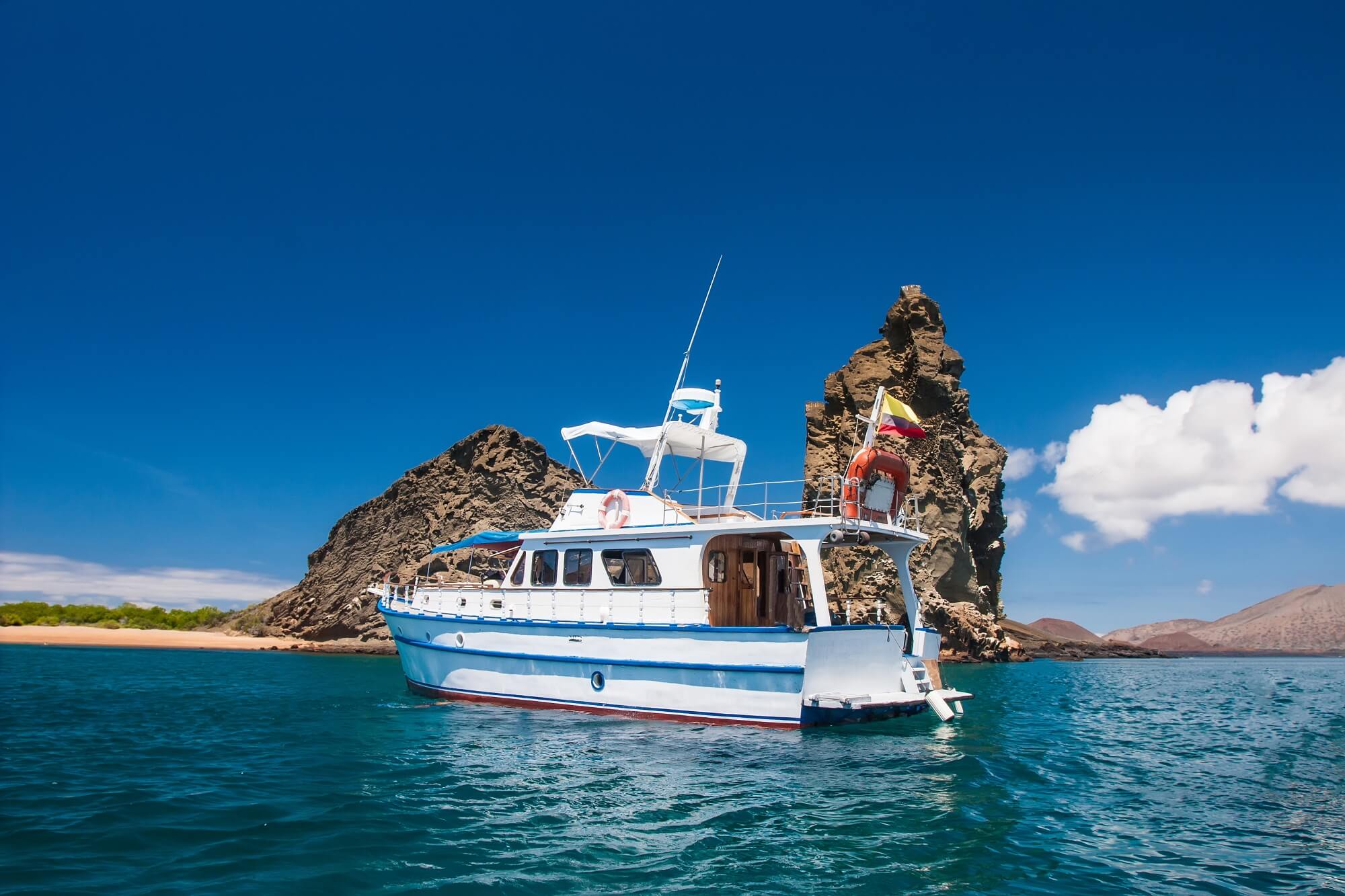
Choose a hotel, or stay onboard a yacht while visiting the Islands.
What to Do in the Galapagos Islands
These incredible islands are an outdoor enthusiast’s dream. You can swim, surf and kayak to your hearts’ content here, and you’ll find that there are more than a few clean, beautiful beaches where it’s possible to relax in near solitude.
If you enjoy hiking, there are many opportunities to do so. From dried lava beds to active volcano rims, to the highlands where you’ll encounter unique vegetation, the landscapes here are as intriguing as they are varied.
Underwater exploration isn’t limited to divers only; there are plenty of great snorkeling spots that are teeming with fish and other fascinating marine life.
Galapagos Animals
Most visitors are here to see the animals! There are countless marine species here plus a fascinating cast of characters inhabiting dry land. Of these, there are a few standouts including frigates, bluefooted boobies, numerous finch species, and an incredible “Who’s who” list of seabirds and shorebirds.
Giant Galapagos Tortoises can be seen at Santa Cruz, Isabela, and San Cristobal islands, as well as in some other locations. To guarantee encounters, consider visiting one of the Giant Tortoise breeding centers. There’s one at San Cristobal’s Galapagos Interpretation Center, and another at the Charles Darwin Research Center located at Santa Cruz. Isabela’s Puerto Villamil is home to a less-crowded breeding center where you might even have the opportunity to hold an adorable baby tortoise in your hands.
Isabela’s Tagus Cove is home to about 35 percent of the Galapagos tortoise population, and it’s also the best place to see lots of penguins and pink flamingos, along with lovely little Darwin finches and other birds. This is also the site of an interesting piece of the Islands’ human history: It’s home to the Wall of Tears, which was built by prisoners who once lived in a penal colony here and built the wall as part of their punishment.
You’ll find Marine Iguanas and curious sea lions at Fernandina, along with sleek, flightless cormorants. If you’re hoping to encounter albatross, you’ll want to visit Espanola’s Punta Espinosa. The albatross nesting period occurs between April and November so plan accordingly if witnessing this is among your priorities.
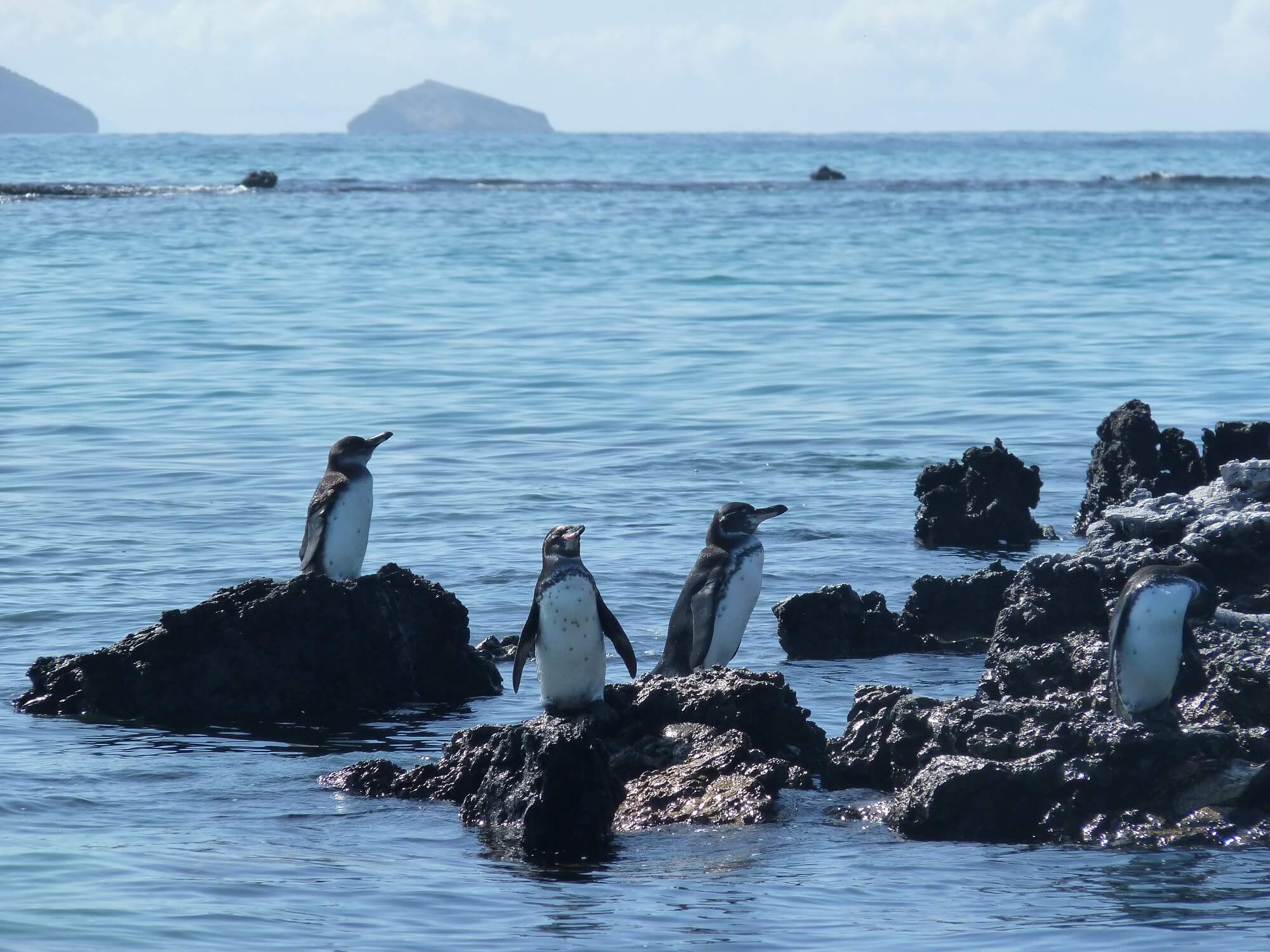
Penguins are often encountered while visiting Galapagos Islands Ecuador.
What’s the best time to visit Galapagos islands Ecuador?
If you’re a diver, you’ll find warmer water temperatures between January and may, however you’ll encounter more marine life between June and November as powerful Humboldt currents bring an abundance of plankton. In the event that you’re more interested in land-based adventures, you can plan your vacation for any time that’s convenient for you.
Galapagos Islands Weather
You’ll find that January through May tend to be warm and wet, with March and April typically offering the hottest temperatures and the most rain. Cooler, drier weather visits Galapagos Islands Ecuador throughout the remainder of the year.
Although the dry season lasts from June through December, it’s still possible to encounter light rain or mist. Skies are often overcast during the dry season even when no rain falls. If you’re hoping for bright blue skies, consider coming during the rainy season since the clouds clear between showers.
Galapagos temperatures rarely drop below the mid-60. During the wet season, daytime highs average between 85 and 90 degrees F; during the dry season, highs are normally around 79 degrees F.
What to Pack for Your Galapagos Islands Travel Adventure
Deciding what to bring to the islands can be tough since you have a limited amount of space and you don’t want to wrangle more luggage than is absolutely necessary. Here’s our suggested packing list.
-
-
- A hat with a brim
- Sunglasses
- Light rain gear, i.e. hooded jacket, waterproof bags for electronics / cameras
- Camera
- Binoculars
- Reef-safe high SPF sunscreen
- Insect repellent
- Comfortable, casual clothing suitable for warm to hot weather
- Durable walking shoes with closed toes for hiking rocky trails
- Flip-flops and/or sandals; heels are not recommended
- Rash guard for snorkeling & swimming
- Your own snorkeling / dive gear if you have it and don’t want to rely on what’s offered by the tour companies
- Basic medications like acetaminophen, any prescriptions, and motion sickness medication if needed
-
You’ll need $100 in US currency to get into the park, unless that fee is included in your tour package. Carry a credit card or two for shopping and dining, plus extra cash to cover tips, taxi fare, and other small expenses. Even though there are a few ATMs on San Cristobal and Santa Cruz islands, they have a tendency to run out of money. Ecuador’s official currency is the U.S. Dollar.
FAQ: Everything You Ever Wanted to Know About the Galapagos Islands
Here are a few more facts to make your trip planning a little easier.
Q: Where are the Galapagos Islands Located?
A: The islands are situated 563 miles west of the continental portion of Ecuador.
Q: What fees are required for visiting Islas Galapagos?
A: The National Park entrance fee is $100 for adults and $50 for children under 12. There is a $20 Transit Control Card fee per person, as well. The national park fee is paid when you arrive at Galapagos airport, and the Transit Control Card fee is paid at Guayaquil or Quito airport.
Q: How many Galapagos airports are there?
A: There’s a small airport on Isabela for inter-island flights. Arrivals from mainland Ecuador land at either Baltra Santa Cruz or San Cristobal.
Q: How many islands in the Galapagos?
A: Officially, there are 21 islands. 18 of these are considered to be major islands, plus there are dozens of smaller islets scattered throughout the region.
Q: How long should I stay in the Galapagos Islands?
A: The longer you stay, the more you will see and experience. Short itineraries of about 5 days will let you see some highlights while longer ones of 14+ days will increase the number of wildlife encounters and other experiences you enjoy. Most people opt to stay for about a week.
Q: What to do in in the Galapagos Islands, besides enjoy nature?
A: There’s not a lot else to do here. During your downtime you might want to nap, read a book, or just wander the beach.
Q: What will I see at Galapagos National Park?
A: Besides a fascinating volcanic landscape and amazing rock formations underwater, the park’s main attraction is animals. Marine iguanas, tortoises, and Galapagos crabs are a few to watch for.
More to Explore
Many travelers come to Ecuador specifically to visit the Galapagos Islands, but there’s much more to experience! Come to Montanita if you’re interested in world-class whale watching, surfing, or a beach vacation, and don’t miss Banos, the “Gateway to the Amazon.” Other major points of interest include the “Cinnamon capital” and whitewater rafting paradise of Tena, and Cuenca, which is Ecuador’s third-largest city and home to a fascinating UNESCO World Heritage Site. With many tours and packages to choose from, these destinations provide an intimate glimpse into Ecuador’s rich natural and cultural heritage.



